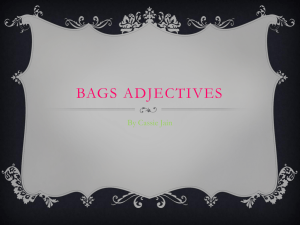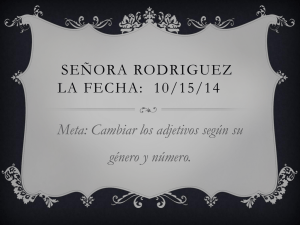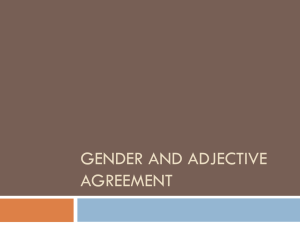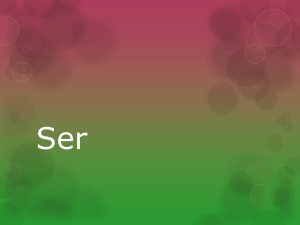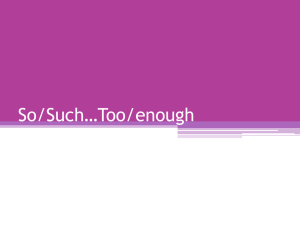Les Adjectifs
advertisement
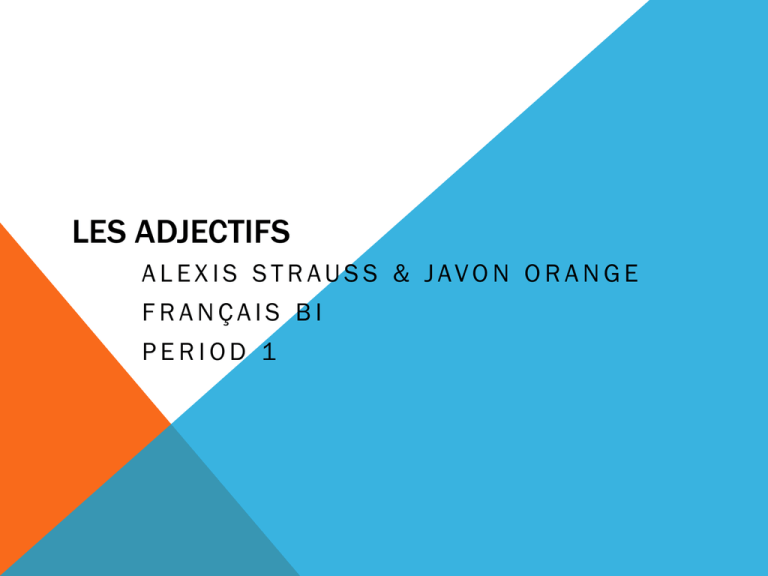
LES ADJECTIFS A L E X I S ST R AU S S & JAVO N O R A N G E FRANÇAIS BI PERIOD 1 WHAT WE SHOULD ALREADY KNOW ABOUT FRENCH ADJECTIVES… French adjectives change in order to agree with the gender and number of the noun(s) that they modify, meaning there can be up to four forms of a given adjective Masculine singular Feminine singular Masculine plural Feminine plural In English, adjectives are placed before the noun, while most French adjectives follow the noun they modify Example: Un livre vert. vs. A green book. ADJECTIVES BEFORE THE NOUN (ANTÉPOSÉ) Certain adjectives are placed before the noun, some which you can memorize with the acronym "BANGS” Beauty: beau/belle and joli(e) -Age: vieux/vieille and nouveau -Numbers -Good : bon/bonne (not mauvais) -Size: petit(e) and grand - PLACEMENT OF ADJECTIVE DEPENDS ON MEANING! Some adjectives have both a figurative and literal meaning and can be placed on either side of the noun When the adjective is figurative, it goes BEFORE the noun When the adjective is literal, it goes AFTER the noun EXAMPLES AGREEMENT WITH ADJECTIVES French adjectives change to agree in gender and number with the nouns that they modify, which means there can be up to four forms of each adjective. The different forms for adjectives depend mostly on the final letter(s) of the default form of the adjective, which is the masculine singular. Most French adjectives add E for feminine and S for plural. This rule applies to adjectives that end in most consonants as well as all vowels except the unaccented E. It also includes all regular and most irregular present participles and past participles EXAMPLES Adjective: amusant Masculine singular amusant Feminine singular amusante Masculine plural amusants Feminine plural amusantes When the masculine singular adjective ends in an unaccented E, there is no difference between the masculine and feminine forms Example: Adjective: rouge (red) Masculine singular rouge Feminine singular rouge Masculine plural rouges Feminine plural rouges When the default form of the adjective ends in S or X, there is no difference between the masculine singular and plural forms: Example: Adjective: gris Masculine singular gris Feminine singular grise Masculine plural gris Feminine plural grises IRREGULAR ADJECTIVES Adjectives that end in a vowel plus L or N usually become feminine by doubling the consonant before adding E. • Ending: el > elle Adjective: personnel Masculine singular personnel Feminine singular personnelle Adjectives that end in er or et need a grave accent • Ending: er > ère Adjective: cher Masculine singular cher Feminine singular chère Other final letters lead to very irregular feminine endings • C CHE (blanc to blanche) EUX EUSE (heureux heureuse) ORDINAL (ADJECTIFS ORDINAUX) Ordinal: adjectives which give relative numeric information, indicating the order or sequence of things: first, second, third, etc. EX. Sept septième Vingt et un vingt et unième Excluding: première, deuxième /seconde, cinq cinquième (u is added), and neuf neuvième ( v is added) Agree with number and gender of noun MINI QUIZ!!! un _____ espoir a) fou b) fous c) folles d) fol les _____ ordinateurs a) nouveau b) nouvels c) nouvelles d) nouveaux ANSWERS un _____ espoir a) fou b) fous c) folles d) fol les _____ ordinateurs a) nouveau b) nouvels c) nouvelles d) nouveaux MINI QUIZ PT.2 40th in French is a) Quarantième b) Quarantuième 5th in French is a) Cinqième b) Cinquième ANSWERS 40th in French is a) Quarantième b) Quarantuième 5th in French is a) Cinqième b) Cinquième
